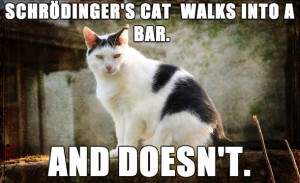 Michael Shermer and Sam Harris got together with an audience at Caltech to beat up on Deepak Chopra and a “storyteller” named Jean Houston in The Future of God debate hosted by ABC News. And Deepak got uncharacteristically angry back behind his crystal-embellished eyewear, especially at Shermer’s assertion that Deepak is just talking “woo-woo.”
Michael Shermer and Sam Harris got together with an audience at Caltech to beat up on Deepak Chopra and a “storyteller” named Jean Houston in The Future of God debate hosted by ABC News. And Deepak got uncharacteristically angry back behind his crystal-embellished eyewear, especially at Shermer’s assertion that Deepak is just talking “woo-woo.”
But is there any basis for the woo-woo that Deepak is weaving? As it turns out, he is building on some fairly impressive work by Stuart Hameroff, MD, of University of Arizona and Sir Roger Penrose of Oxford University. Under development for more than 25 years, this work has most recently been summed up in their 2014 paper, “Consciousness in the universe: A review of the ‘Orch OR’ theory” available for free (but not the commentaries, alas). Deepak was even invited to comment on the paper in Physics of Life Reviews, though the content of his commentary was challenged as being somewhat orthogonal or contradictory to the main argument.
To start somewhere near the beginning, Penrose became obsessed with the limits of computation in the late 80s. The Halting Problem sums up his concerns about the idea that human minds can possibly be isomorphic with computational devices. There seems to be something that allows for breaking free of the limits of “mere” Turing Complete computation to Penrose. Whatever that something is, it should be physical and reside within the structure of the brain itself. Hameroff and Penrose would also like that something to explain consciousness and all of its confusing manifestations, for surely consciousness is part of that brain operation.
Now, to get at some necessary and sufficient sorts of explanations for this new model requires looking at Hameroff’s medical speciality: anesthesiology. Anyone who has had surgery has had the experience of consciousness going away while body function continues on, still mediated by brain activities. So certain drugs like halothane erase consciousness through some very targeted action. Next, consider that certain prokaryotes have internally coordinated behaviors without the presence of a nervous system. Finally, consider that it looks like most neurons do not integrate and fire like the classic model (and the model that artificial neural networks emulate), but instead have some very strange and random activation behaviors in the presence of the same stimuli.
How do these relate? Hameroff has been very focused on one particular component to the internal architecture of neural cells: microtubules or MTs. These are very small (compared to cellular scale) and there are millions in neurons (10^9 or so). They are just cylindrical polymers with some specific chemical properties. They also are small enough (25nm in diameter) that it might be possible that quantum effects are present in their architecture. There is some very recent evidence to this effect based on strange reactions of MTs to tiny currents of varying frequencies used to probe them. Also, anesthetics appear to bind to MTs, Indeed, they could also provide a memory strata that is orders of magnitude greater than the traditional interneuron concept of how memories form.
But what does this have to do with consciousness beyond the idea that MTs get interfered with by anesthetics and therefore might be around or part of the machinery that we label conscious? They also appear to be related to Alzheimer’s disease, but this could be just related to the same machinery. Well, this is where we get woo-woo-ey. If consciousness is not just an epiphenomena arising from standard brain function as a molecular computer, and it is also not some kind of dualistic soul overlay, then maybe it is something that is there but is not a classical computer. Hence quantum effects.
So Sir Penrose has been promoting a rather wild conjecture called the Diósi-Penrose theory that puts an upper limit on the amount of time a quantum superposition can survive. It does this based on some arguments I don’t fully understand but that integrate gravity with quantum phenomena to suggest that the mass displaced by the superposed wave functions snaps the superposition into wave collapse. So Schrödinger’s cat dies or lives very quickly even without an observer because there are a lot of superposed quantum particles in a big old cat and therefore very rapid resolution of the wave function evolution (10^-24s). Single particles can live in superposition for much longer because the mass difference between their wave functions is very small.
Hence the OR in “Orch OR” stands for Objective Resolution: wave functions are subject to collapse by probing but they also collapse just because they are unstable in that state. The resolution is objective and not subjective. The “Orch” stands for “Orchestrated.” And there is the seat of consciousness in the Hameroff-Penrose theory. In MTs little wave function collapses are constantly occurring and the presence of superposition means quantum computing can occur. And the presence of quantum computing means that non-classical computation can take place and maybe even be more than Turing Complete.
Now the authors are careful to suggest that these are actually proto-conscious events and that only their large-scale orchestration leads to what we associate with consciousness per se. Otherwise they are just quantum superpositions that collapse, maybe with 1 qubit of resolution under the right circumstances.
At least we know the cat has a fate now. That fate is due to an objective event, too, and not some added woo-woo from the strange world of quantum phenomena. And the cat’s curiosity is part of the same conscious machinery.
fixed spelling of the cat master